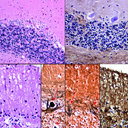Growth-factor-driven rescue to receptor tyrosine kinase (RTK) inhibitors through Akt and Erk phosphorylation in pediatric low grade astrocytoma and ependymoma.
الكلمات الدالة
نبذة مختصرة
Up to now, several clinical studies have been started investigating the relevance of receptor tyrosine kinase (RTK) inhibitors upon progression free survival in various pediatric brain tumors. However, single targeted kinase inhibition failed, possibly due to tumor resistance mechanisms. The present study will extend our previous observations that vascular endothelial growth factor receptor (VEGFR)-2, platelet derived growth factor receptor (PDGFR)β, Src, the epidermal growth factor receptor (ErbB) family, and hepatocyte growth factor receptor (HGFR/cMet) are potentially drugable targets in pediatric low grade astrocytoma and ependymoma with investigations concerning growth-factor-driven rescue. This was investigated in pediatric low grade astrocytoma and ependymoma cell lines treated with receptor tyrosine kinase (RTK) inhibitors e.g. sorafenib, dasatinib, canertinib and crizotinib. Flow cytometry analyses showed high percentage of cells expressing VEGFR-1, fibroblast growth factor receptor (FGFR)-1, ErbB1/EGFR, HGFR and recepteur d'origine nantais (RON) (respectively 52-77%, 34-51%, 63-90%, 83-98%, 65-95%). Their respective inhibitors induced decrease of cell viability, measured with WST-1 cell viability assays. At least this was partially due to increased apoptotic levels measured by Annexin V/Propidium Iodide apoptosis assays. EGF, HGF and FGF, which are normally expressed in brain (tumor) tissue, showed to be effective rescue inducing growth factors resulting in increased cell survival especially during treatment with dasatinib (complete rescue) or sorafenib (partial rescue). Growth-factor-driven rescue was less prominent when canertinib or crizotinib were used. Rescue was underscored by significantly activating downstream Akt and/or Erk phosphorylation and increased tumor cell migration. Combination treatment showed to be able to overcome the growth-factor-driven rescue. In conclusion, our study highlights the extensive importance of environmentally present growth factors in developing tumor escape towards RTK inhibitors in pediatric low grade astrocytoma and ependymoma. It is of great interest to anticipate upon these results for the design of new therapeutic trials with RTK inhibitors in these pediatric brain tumors.


